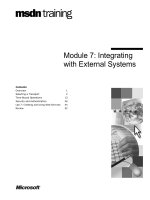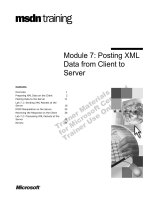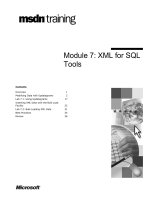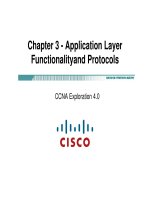Tài liệu Module 7- Data Link Layer CCNA Exploration 4.0 pptx
Bạn đang xem bản rút gọn của tài liệu. Xem và tải ngay bản đầy đủ của tài liệu tại đây (78.85 MB, 64 trang )
Module 7- Data Link Layer
CCNA Exploration 4.0
1
CCNA Exploration 4.0
Overview
2Học viện mạng Bách khoa - Website: www.bkacad.com
Overview
Upon completion of this chapter, you will be able to:
• Explain the role of Data Link layer protocols in data transmission.
• Describe how the Data Link layer prepares data for transmission on
network media.
• Describe the different types of media access control methods.
• Identify several common logical network topologies and describe how
the logical topology determines the media access control method for
3
the logical topology determines the media access control method for
that network.
• Explain the purpose of encapsulating packets into frames to facilitate
media access.
• Describe the Layer 2 frame structure and identify generic fields.
• Explain the role of key frame header and trailer fields, including
addressing, QoS, type of protocol, and Frame Check Sequence.
Học viện mạng Bách khoa - Website: www.bkacad.com
Data Link Layer –
Accessing the Media
4
Accessing the Media
Học viện mạng Bách khoa - Website: www.bkacad.com
Supporting & Connecting to Upper Layer Services
• The Data Link layer
provides a means for
exchanging data over a
common local media.
• The Data Link layer
performs two basic
services:
– Allows the upper
layers to access the
media using
5
media using
techniques such as
framing
– Controls how data
is placed onto the
media and is
received from the
media using
techniques such as
media access
control and error
detection
Học viện mạng Bách khoa - Website: www.bkacad.com
Supporting & Connecting to Upper Layer Services
6
• The Data Link layer effectively insulates the communication processes at the
higher layers from the media transitions that may occur end-to-end.
• A packet is received from and directed to an upper layer protocol, in this case
IPv4 or IPv6, that does not need to be aware of which media the communication
will use.
Học viện mạng Bách khoa - Website: www.bkacad.com
Controlling Transfer across Local Media
7
• The media access control methods described by the Data Link layer protocols
define the processes by which network devices can access the network media
and transmit frames in diverse network environments.
Học viện mạng Bách khoa - Website: www.bkacad.com
Creating a Frame
8
• Control information may tell:
– Which nodes are in communication with each other.
– When communication between individual nodes begins and when it
ends.
– Which errors occurred while the nodes communicated.
– Which nodes will communicate next.
Học viện mạng Bách khoa - Website: www.bkacad.com
Creating a Frame
9
• Framing breaks the stream into decipherable groupings, with control information
inserted in the header and trailer as values in different fields.
• This format gives the physical signals a structure that can be received by nodes
and decoded into packets at the destination.
Học viện mạng Bách khoa - Website: www.bkacad.com
Connecting Upper Layer Services to the Media
10
• The Data Link layer exists as a connecting layer between the software
processes of the layers above it and the Physical layer below it.
• As such, it prepares the Network layer packets for transmission across some
form of media, be it copper, fiber, or the atmosphere.
Học viện mạng Bách khoa - Website: www.bkacad.com
Connecting Upper Layer Services to the Media
11
• To support a wide variety of network functions, the Data Link layer is often divided into
two sublayers: an upper sublayer and an lower sublayer.
– The upper sublayer defines the software processes that provide services to the
Network layer protocols.
– The lower sublayer defines the media access processes performed by the hardware.
Học viện mạng Bách khoa - Website: www.bkacad.com
Standards
12Học viện mạng Bách khoa - Website: www.bkacad.com
Media Access Control Techniques
13Học viện mạng Bách khoa - Website: www.bkacad.com
Placing Data on the Media
14
• Regulating the placement of data frames onto the media is known as media access
control.
• The method of media access control used depends on:
– Media sharing - If and how the nodes share the media
– Topology - How the connection between the nodes appears to the Data Link layer
Học viện mạng Bách khoa - Website: www.bkacad.com
Media Access Control for Shared Media
15
• There are two basic media access control methods for shared media:
– Controlled - Each node has its own time to use the medium
– Contention-based - All nodes compete for the use of the medium
Học viện mạng Bách khoa - Website: www.bkacad.com
Controlled
16
• When using the controlled access method, network devices take turns, in
sequence, to access the medium. This method is also known as scheduled
access or deterministic.
• Although controlled access is well-ordered and provides predictable
throughput, deterministic methods can be inefficient because a device has to
wait for its turn before it can use the medium.
Học viện mạng Bách khoa - Website: www.bkacad.com
Contention-Based
17
• Also referred to as non-deterministic, contention-based methods allow any
device to try to access the medium whenever it has data to send.
• To prevent complete chaos on the media, these methods use a Carrier Sense
Multiple Access (CSMA) process to first detect if the media is carrying a
signal.
Học viện mạng Bách khoa - Website: www.bkacad.com
Media Access Control for Shared Media
• CSMA is usually implemented in conjunction with a method for resolving the
media contention.
• The two commonly used methods are:
– CSMA/Collision Detection
• In CSMA/Collision Detection (CSMA/CD), the device monitors the
media for the presence of a data signal. If a data signal is absent,
indicating that the media is free, the device transmits the data. If
18
signals are then detected that show another device was transmitting at
the same time, all devices stop sending and try again later.
• Traditional forms of Ethernet use this method.
– CSMA/Collision Avoidance
• In CSMA/Collision Avoidance (CSMA/CA), the device examines the
media for the presence of a data signal. If the media is free, the device
sends a notification across the media of its intent to use it. The device
then sends the data.
• This method is used by 802.11 wireless networking technologies.
Học viện mạng Bách khoa - Website: www.bkacad.com
Media Access Control for Non-Shared Media
19
• Media access control protocols for non-shared media require little or no control
before placing frames onto the media.
• These protocols have simpler rules and procedures for media access control.
Such is the case for point-to-point topologies.
• In point-to-point connections, the Data Link layer has to consider whether the
communication is half-duplex or full-duplex.
Học viện mạng Bách khoa - Website: www.bkacad.com
Media Access Control for Non-Shared Media
20
• In full-duplex communication, both devices can transmit and receive on the
media at the same time.
• The Data Link layer assumes that the media is available for transmission for
both nodes at any time. Therefore, there is no media arbitration necessary in
the Data Link layer.
Học viện mạng Bách khoa - Website: www.bkacad.com
Media Access Control for Non-Shared Media
21
• Half-duplex communication means that the devices can both transmit and
receive on the media but cannot do so simultaneously.
• Ethernet has established arbitration rules for resolving conflicts arising from
instances when more than one station attempts to transmit at the same time.
Học viện mạng Bách khoa - Website: www.bkacad.com
Logical Topology vs Physical Topology
• The topology of a network is the
arrangement or relationship of the
network devices and the
interconnections between them.
• Network topologies can be viewed
at the physical level and the logical
22
at the physical level and the logical
level.
• Logical and physical topologies
typically used in networks are:
– Point-to-Point
– Multi-Access
– Ring
Học viện mạng Bách khoa - Website: www.bkacad.com
Logical Topology vs Physical Topology
23
• The physical topology is an arrangement of the nodes and the physical
connections between them.
• The representation of how the media is used to interconnect the devices is the
physical topology.
Học viện mạng Bách khoa - Website: www.bkacad.com
Logical Topology vs Physical Topology
• A logical topology is the way a network transfers frames from one
node to the next.
– This arrangement consists of virtual connections between the
nodes of a network independent of their physical layout.
– These logical signal paths are defined by Data Link layer
protocols.
• The Data Link layer "sees" the logical topology of a network when
24
• The Data Link layer "sees" the logical topology of a network when
controlling data access to the media. It is the logical topology that
influences the type of network framing and media access control used.
• The physical or cabled topology of a network will most likely not be the
same as the logical topology.
Học viện mạng Bách khoa - Website: www.bkacad.com
Point-to-Point Topology
25
• A point-to-point topology connects 2 nodes directly together.
• In data networks with point-to-point topologies, the media access control
protocol can be very simple.
• In point-to-point networks, if data can only flow in one direction at a time, it is
operating as a half-duplex link. If data can successfully flow across the link
from each node simultaneously, it is a full-duplex link.
Học viện mạng Bách khoa - Website: www.bkacad.com









